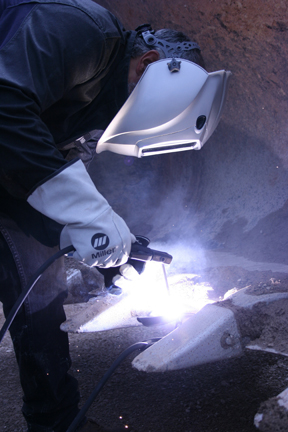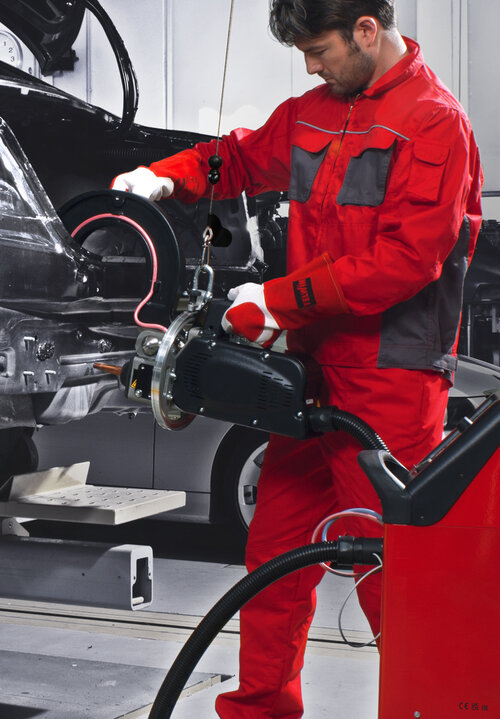Usual Welding Repair Service Issues and How to Address Them Successfully
Welding fixings frequently experience a series of problems that can endanger the integrity of the end product. Common problems include inadequate infiltration, porosity, and imbalance, to name a few. Each flaw provides unique obstacles that require particular techniques for resolution. Recognizing these problems is essential for welders aiming to improve their abilities and outcomes. This discussion will discover these typical welding fixing problems and efficient methods to address them.
Inadequate Penetration
Poor penetration takes place when the weld steel falls short to completely fuse with the base product, causing weak joints and potential architectural failures. This concern often stems from insufficient warmth input, wrong electrode angle, or improper welding rate. Welders might come across inadequate infiltration due to a mistake of the essential criteria for a details material density or type. Additionally, contamination on the base material's surface area can hinder efficient bonding, exacerbating the problem. To resolve poor penetration, welders must assure proper settings on their equipment and maintain a clean work surface area. Routine examination of welds is advised to determine any kind of shortages early, permitting timely modifications and the avoidance of endangered structural honesty in bonded assemblies.
Porosity
Porosity is an usual defect in welded joints that manifests as little gas bubbles caught within the weld metal. This flaw can jeopardize the stability of the weld, causing reduced stamina and possible failure under anxiety. Montana Mobile Welding and Repair Belgrade Welding. Porosity typically occurs from contamination, wetness, or improper welding methods, which allow gases to get away into the molten weld pool. To address porosity, welders need to guarantee correct surface area preparation, maintain a clean workplace, and utilize ideal welding criteria. Furthermore, selecting the ideal filler product and protecting gas can reduce gas entrapment. Routine examination and screening of welds can aid identify porosity early, guaranteeing timely rehabilitative activities are taken, therefore maintaining the top quality and dependability of the welded structure
Misalignment
Misalignment in welding can emerge from various elements, including incorrect configuration and thermal expansion. Comprehending the origin is necessary for reliable resolution. Several correction methods are offered to straighten components and ensure structural integrity.
Sources of Imbalance
Welding misalignment usually originates from a selection of underlying problems that can compromise architectural integrity. One main reason is improper fit-up of elements before welding, which can result in voids and unequal surface areas. Variations in thermal expansion during the welding procedure can additionally lead to distortion, specifically if the materials being signed up with have various coefficients of development. Furthermore, insufficient fixturing and clamping may fall short to hold elements securely in position, bring about motion during welding. Improperly kept tools, including welding machines and devices, may present disparities in the weld grain, more contributing to imbalance. Operator error, stemming from not enough training or experience, can likewise play a substantial function in creating misaligned welds.

Modification Methods Available
Dealing with imbalance efficiently needs a combination of restorative methods tailored to the particular concerns at hand. One typical technique is using fixtures or jigs to hold components in the correct setting throughout welding, making certain regular positioning. In addition, pre-heating the products can aid minimize distortion and boost fit-up. For substantial misalignment, mechanical adjustment methods, such as making use of hydraulic jacks or clamps, can be used to remedy the position before welding. Post-weld heat therapy may likewise be required to eliminate anxieties triggered by imbalance. Careful inspection and modification throughout the setup phase can stop imbalance problems from ending up being considerable issues, advertising a smoother welding procedure and enhancing general architectural honesty.
Distortion
Distortion is a common challenge in welding that can develop from numerous variables, including uneven heating & cooling. Understanding the reasons of distortion is important for executing reliable avoidance techniques. Addressing this issue not only boosts architectural honesty however likewise enhances the overall top quality of the weld.
Sources of Distortion
When based on the intense warmth of welding, materials commonly undertake adjustments that can cause distortion. This phenomenon largely emerges from thermal growth and contraction throughout the welding process. As the weld area heats up, the material expands; upon air conditioning, it contracts, which can develop interior stresses. In enhancement, uneven home heating throughout a workpiece can intensify these tensions, causing bending or flexing. The kind of product additionally plays a significant function; steels with varying thermal conductivity and coefficients of expansion may react in a different way, resulting in unforeseeable distortions. Additionally, inadequate joint layout and insufficient fixturing can add to imbalance during welding, boosting the likelihood of distortion. Understanding these reasons is vital for efficient welding repair service and prevention methods.
Prevention Techniques
Efficient prevention strategies for distortion during welding focus on managing warmth input and making sure correct joint layout. Keeping a regular heat input helps to reduce thermal expansion and tightening, which can bring about distortion. Utilizing techniques such as preheating the workpiece can likewise minimize the temperature gradient, promoting uniform home heating. In addition, picking appropriate joint designs, such as T-joints or lap joints, can enhance security and decrease anxiety focus. Carrying out correct fixturing to protect the workpieces in area additionally aids in keeping positioning throughout the welding procedure. Staggered welding series can disperse warmth more evenly, stopping local distortion. By using these strategies, welders can significantly decrease the chance of distortion and boost the overall top quality of their welds.
Fracturing
Breaking is an usual problem encountered in welding repair work, frequently resulting from numerous aspects such as improper cooling prices, material choice, or inadequate joint preparation. The incident of cracks can substantially compromise the honesty of the weld, causing possible failings throughout operation. To useful site address this issue, welders should first analyze the origin creates, making certain that products are suitable and properly chosen for the details application. In addition, managing the air conditioning rate during the welding procedure is necessary; quick cooling can generate anxiety and bring about breaking. Correct joint layout and preparation also add to minimizing the threat. Executing these techniques can boost weld quality and toughness, inevitably reducing the likelihood of splitting in ended up weldments.

Incomplete Fusion
A significant concern in welding repairs is incomplete blend, which occurs when the weld metal does not adequately bond with the base material or previous weld passes - Montana Mobile Welding and Repair Belgrade Fabrication. This defect can result in weak points in the joint, possibly jeopardizing the integrity of the bonded framework. Factors adding to insufficient combination include inadequate warm input, inappropriate welding strategy, and contamination of the surfaces being joined. To resolve this issue properly, welders ought to guarantee appropriate pre-weld cleansing and surface prep work, in addition to adjust their welding specifications to achieve ample penetration and combination. Normal inspection throughout the welding process can likewise assist determine insufficient blend early, enabling timely rehabilitative procedures to boost the total quality of the weld
Overheating
While welding fixings can improve architectural integrity, overheating presents a considerable obstacle that can bring about material destruction. Excessive heat during welding can alter the mechanical homes of metals, causing lowered stamina, increased brittleness, and warping. This phenomenon is specifically vital in high-stress applications where architectural reliability is extremely important. Identifying getting too hot can involve aesthetic assessments for discoloration or distortion, along with keeping track of temperature throughout the welding process. To mitigate the risks related to overheating, welders must utilize suitable techniques, such as controlling this post warm input, readjusting traveling rate, and using ideal filler products. Furthermore, implementing pre- and post-weld warm therapies can assist restore product homes and boost the total high quality of the fixing, making sure long-lasting performance and security.
Frequently Asked Concerns
What Are the Typical Indicators of a Welding Flaw?

Exactly How Can I Check My Welds for Top quality?
To examine welds for high quality, one can welding utilize aesthetic inspections, ultrasonic screening, and radiographic approaches. Each strategy assures structural integrity, determines issues, and validates adherence to specified standards, inevitably enhancing the dependability of the welded joints.
What Security Preventative Measures Should I Take While Welding?
When welding, one need to prioritize safety and security by using appropriate individual safety devices, making sure correct air flow, securing combustible products away, maintaining a clean work space, and knowing environments to protect against mishaps and injuries.
Can I Repair a Weld Without Renovating the Entire Joint?
Repairing a weld without remodeling the whole joint is possible, relying on the damages (Belgrade). Strategies such as grinding, including filler product, or making use of a welding procedure can efficiently attend to details imperfections while maintaining the bordering framework
What Tools Are Essential for Effective Welding Fixes?
Crucial tools for efficient welding fixings consist of a welding device, cable brush, grinder, protective gear, clamps, and filler products. Each tool plays a crucial function in guaranteeing quality and safety and security during the fixing process. Porosity normally arises from contamination, wetness, or improper welding methods, which allow gases to escape right into the molten weld pool. Poorly conserved equipment, including welding machines and devices, may present inconsistencies in the weld bead, further contributing to imbalance. When subjected to the extreme warm of welding, products usually undergo adjustments that can lead to distortion. Splitting is a common concern encountered in welding repair work, typically resulting from various factors such as inappropriate cooling prices, material option, or inadequate joint prep work. A significant problem in welding fixings is incomplete combination, which takes place when the weld steel does not adequately bond with the base material or previous weld passes.